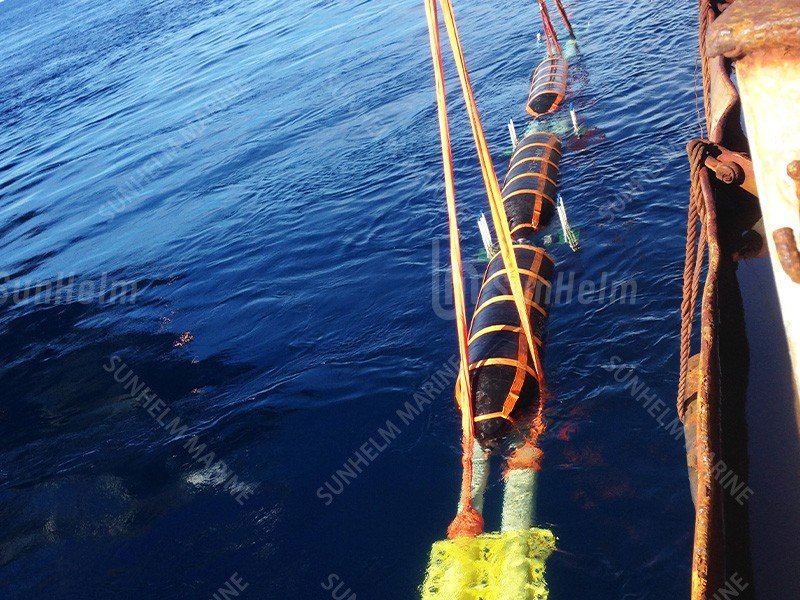Introduction
Floating airbags, also known as marine salvage airbags or buoyancy airbags, are flexible rubber structures filled with compressed air. They are widely used in marine projects such as ship launching, underwater construction, and especially in salvage operations. Compared to traditional lifting methods like cranes or rigid pontoons, floating airbags offer a low-cost, efficient, and highly adaptable solution.
In marine salvage, where time and mobility are critical, floating airbags have proven to be a game-changer. They allow salvage teams to quickly respond to emergencies without relying on expensive, heavy-lift vessels.

Common Applications
Floating airbags are widely used in:
- Refloating grounded vessels
- Raising sunken ships or submarines
- Providing buoyancy for heavy underwater objects
- Supporting underwater construction or bridge foundations
When ships sink or run aground, traditional salvage methods such as using cranes or rigid pontoons are often slow and costly. Floating airbags solve this by being lightweight, portable, and easy to deploy underwater, even in complex conditions like muddy seafloors or tilted hulls.
Advantages Over Rigid Pontoons
Traditional rigid pontoons have strong lifting capacity,y but also have major limitations:
- Large and bulky: Difficult to maneuver underwater
- Hard to secure: Challenging to attach to tilted or buried ship parts
- Expensive: Requires heavy equipment and long setup times
- Limited quantity onboard: One salvage vessel can only carry a few large pontoons
Floating airbags, on the other hand:
- They are lightweight and compact before inflation
- Can be stored and deployed in large numbers
- Easily attach to irregular or submerged surfaces
- Provide even pressure distribution during lifting
- Require lower tension in securing cables
These advantages make floating airbags ideal for large-scale salvage operations.
Step-by-Step Operation Guide
1. Preparation
Before submerging, partially inflate the airbags to give them enough volume for divers or robotic arms to handle. Their low weight allows easy handling even in tight or buried locations. If no steel cable tie points are available—such as in hull sections stuck in sand—flexible suction cups can be used to secure the airbags to the surface.
2. Positioning and Securing
Once the salvage vessel is positioned, drop a guide anchor about 10 meters from the shipwreck. Tie the floating airbag to a weight using a cable with a quick-release ring, and attach the ring to the anchor cable. Lower both the airbag and the weight into the water. They will slide down along the anchor line to the target position. Divers or robotic arms then retrieve the airbag and tie it to designated points.
Special cases:
- For tilted ships: Attach airbags to one side to correct the tilt, then install more on both sides for lifting.
- For suction-mounted operations: Use pumps to create a vacuum in suction pads and stick them onto hull sides.
- For accessible compartments: Place airbags inside, then inflate them to displace water and add internal buoyancy. This reduces weight and simplifies external securing.
3. Inflation and Lifting
Once airbags are securely attached:
- Inflate each airbag gradually using a manifold system to ensure even pressure and balance
- After inflation, connect steel cables from a crane or floating derrick to the shipwreck
- Start lifting slowly. Airbags expand and press tightly against the hull, distributing pressure evenly
- The entire wreck will gradually rise to the surface
Compared to rigid pontoons, floating airbags require less steel cable tension due to their softer contact and larger surface area. This makes securing and lifting safer and easier.
Safety and Efficiency
- Low-risk handling: Compact before inflation, reducing storage and deployment difficulty
- Adaptability: Works well in muddy or uneven seabeds where rigid pontoons fail
- Time-saving: Quick underwater placement with fewer tools and smaller support vessels
- Cost-effective: Eliminate the need for large cranes or heavy pontoons
Conclusion
Floating airbags are a practical, reliable, and efficient solution for marine salvage tasks. Whether raising a sunken ship or refloating a grounded vessel, they provide an affordable alternative to traditional heavy lifting. Their ease of use, flexibility, and transportability make them essential tools for modern salvage companies, especially when speed and adaptability are critical.
If you’re looking to improve your salvage operations, floating airbags may be the smartest investment you can make.


